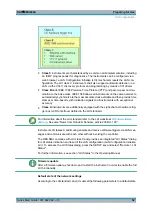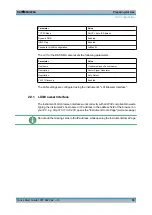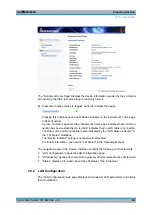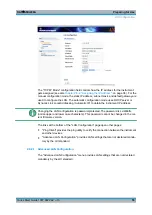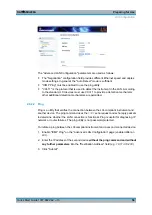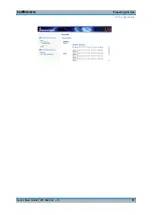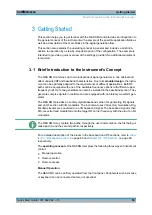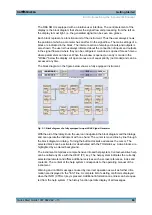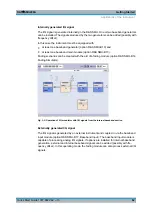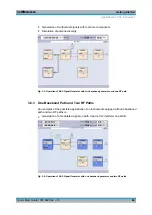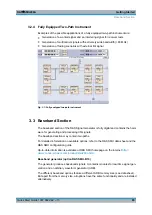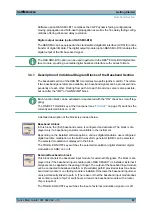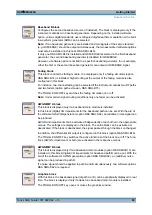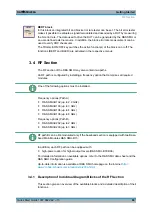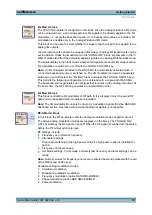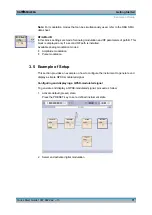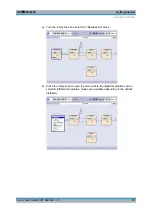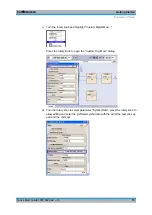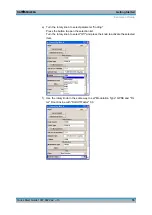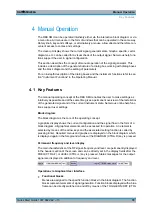
Getting Started
R&S
®
SMU200A
66
Quick Start Guide 1007.9822.62 ─ 13
One or two baseband generators can be fitted in an R&S SMU and operated separately.
Signals from the baseband generators can be routed from path A to B and vice versa,
and added (possibly with frequency offset).
The option Baseband Generator contains real time Custom Digital Modulation and ARB.
Software options providing various digital standards are offered in addition. Option R&S
SMU-K40, for instance, generates signals to GSM/EDGE standard, option R&S SMU-
K42 signals to 3GPP FDD standard.
Baseband input module (option R&S SMU-B17)
With the aid of this module, external I/Q signals can be applied to the baseband section
of the R&S SMU. The I/Q signals can be further processed in the baseband section (e.g.
fading, addition of noise). If the R&S SMU is equipped for internal baseband signal gen-
erators, external and internal baseband signals can be added. The output of the base-
band input module can be connected to baseband path A or path B (if available) provided
at least one baseband main module or one fading module is installed. Otherwise the
baseband input module is permanently linked to path A.
The R&S SMU-B17 option can be used together with the R&S
®
EX-IQ-BOX digital inter-
face module, providing a versatile digital baseband interface with various formats.
Baseband main module (option R&S SMU-B13)
The baseband main module can be installed twice, for each of both paths A and B
respectively.
At the end of the baseband path, the digital signal is converted to an analog I/Q signal.
The analog I/Q signal is fed to the I/Q modulator of the RF path. This module also routes
signals to the analog I/Q outputs. The module is absolutely required for coupling out the
baseband signal from the baseband section.
At this stage routing from A to B or vice versa is no longer possible. If a two-path RF
section is available, two baseband main modules are required if the signals from the
baseband section are to be output to the two RF paths.
This module also offers digital I/Q impairment functions. The I/Q signal can be deliberately
corrupted, e.g. for testing the receiver quality.
Additional White Gaussian Noise (option R&S SMU-K62)
Additive white noise, which may be required for instance for measurements on mobile
radio base stations, can be produced with the AWGN software option (R&S SMU-K62).
Fading module (option R&S SMU-B14)
This module enables fading effects to be produced on baseband signals in real time. In
the case of TDMA fading, up to 20 fading paths (40 fading paths with option R&S SMU-
B15) can be created simultaneously.
Provided two RF paths are installed, option R&S SMU-B15 permits also real two-channel
fading irrespective of the RF carrier spacing of the two channels.
Baseband Section
Содержание 1141.2005.02
Страница 27: ......
Страница 74: ...Preparing for Use R S SMU200A 57 Quick Start Guide 1007 9822 62 13 LXI Configuration ...
Страница 75: ......
Страница 95: ......
Страница 134: ...Manual Operation R S SMU200A 117 Quick Start Guide 1007 9822 62 13 Legend of Front Panel Controls ...
Страница 135: ......
Страница 140: ...Hardware Interfaces R S SMU200A 123 Quick Start Guide 1007 9822 62 13 Fig 1 2 BERT circuit diagram BERT Connector ...
Страница 141: ......
Страница 144: ...Index R S SMU200A 127 Quick Start Guide 1007 9822 62 13 Winbar 89 Windows XP 33 access 34 ...

